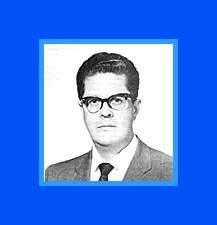Guillermo González Camarena
| Guillermo González Camarena | |
|---|---|
 Guillermo González Camarena | |
| Born |
17 February 1917 Guadalajara, Jalisco, Mexico |
| Died |
18 April 1965 (aged 48) Puebla, Mexico |
| Nationality | Mexican |
| Education | National Polytechnic Institute |
| Occupation | Engineer |
| Spouse(s) | María Antonieta Becerra Acosta |
| Engineering career | |
| Discipline | Electrical engineer |
| Projects | Chromoscopic adapter for television equipment |
Guillermo González Camarena (17 February 1917 – 18 April 1965), was a Mexican electrical engineer who was the inventor of a color-wheel type of color television, and who also introduced color television to Mexico.
Early life
González Camarena was born in Guadalajara to Arturo González and Sara Camarena.
His twin brother Jorge González Camarena was a prominent painter, muralist and sculptor.
Career and inventions
González Camarena invented the "Chromoscopic Adapter for Television Squipment", an early color television transmission system. He was only 17. A U.S. patent application (2,296,019) states, "My invention relates to the transmission and reception of colored pictures or images by wire or wireless..." The invention was designed to be easy to adapt to black-and-white television equipment. González Camarena applied for this patent August 14, 1941, and obtained the patent September 15, 1942. He also filed for additional patents for color television systems in 1960 and 1962. He sold his fist set in 1954 and sold it for about $1450.
On August 31, 1946, González Camarena sent his first color transmission from his lab in the offices of The Mexican League of Radio Experiments, at Lucerna St. #1, in Mexico City. The video signal was transmitted at a frequency of 115 MHz. and the audio in the 40-meter band.
He obtained authorization to make the first publicly announced color broadcast in Mexico, on February 8, 1963, Paraíso Infantil, on Mexico City's XHGC-TV, a station that he established in 1952. By that time, the government had adopted NTSC as the television color system.
Death
He died in a car accident in Puebla on April 18, 1965, returning from inspecting a television transmitter in Las Lajas, Veracruz.
Legacy
A field-sequential color television system similar to his Tricolor system was used in NASA's Voyager mission in 1979, to take pictures and video of Jupiter.[1]
In 1995, a Mexican science research and technology group created La Fundación Guillermo González Camarena (The Guillermo González Camarena Foundation), which benefits creative and talented inventors in Mexico.
At the same time, the IPN began construction on the Centro de Propiedad Intelectual "Guillermo González Camarena" (Guillermo González Camarena Intellectual Property Center).